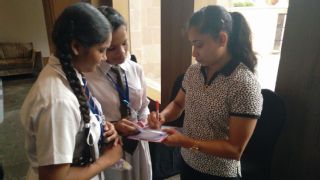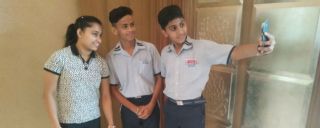|
Dipa Karmakar was surrounded by girls and boys seeking autographs, selfies and increased proximity. When the crowd thinned a little, she was unafraid to look absurd and quickly hopped up and down on her right leg, telling a small group around her, "See, see... it's getting better." Dipa was at a Delhi hotel on Thursday, brand ambassador for a tea company pushing to make sports compulsory in the school curriculum. As she hopped on one leg, her beam was on full megawattage. She wanted to announce that her right knee - operated on four months ago for an anterior cruciate ligament (ACL) tear - was on its way to getting stronger. It is still a couple of months away from being perfect, but it is certainly better than what India's path-breaker gymnast had to do to get around a few months ago: lean on a walker or use elbow crutches. By next April, a year since surgery on her ACL, Dipa wants to be flying instead. To a town called Coomera on Australia's Gold Coast, venue of the 2018 Commonwealth Games. The CWG is where she came to international notice, with a 2014 Glasgow bronze, and it is where she wants to let the world know she is back, as determined a contender as always. The year that followed Dipa's breakout performance at the Rio Olympics was full to the brim with recognition, acclaim and awards. But, to her distress, Dipa has been deprived of that most vital element of herself: competition. "I thought after the Olympics there'd be so much more I'd be able to do and go to, and then I got injured." The ACL is the ligament connecting the knee joint to the shin and Dipa had returned from Rio with a Grade Two (moderate) injury. After the post-Olympics buzz had died down, she resumed training for the Asian Championships in May but, a week into practice, she tore the ligament and was sent to the operating table. Her doctor, Anant Joshi, has given her six months to return to practice and, along with the Asian Championship, she will have to miss the year's World Championships in Canada. "I was very sad to give the Asian and now the Worlds a miss," she says. The slowdown of Dipa's ambitions is being handled however with a wider view. "Gymnasts who've been injured and had surgery have come back and I see them doing well so why can't I? It's all about time. I didn't like using the sticks and the walker, it was difficult. "I would think why did I get so badly hurt, but now I think if this was to happen to me after a year and half, it would be a big problem. So if it had to happen, it's better now. I live with the thought that God does what he does for a reason, so okay." Her memories of the operation are two: seeing her coach Bisweswar Nandi in tears ("I'm scared of needles," he explains) and hearing the doctors chatting to her after putting her under. As the anesthesia took effect, they were asking her what she wanted to do, and where she wanted to go. Dipa replied, "I want to go to my gymnastics hall, send me there." Nandi was a wreck, he says, not only because of the needles and the scalpels, but something more. "I sometimes think I am her guru, her teacher, father, mother, sister, saheli (friend) and if she feels any pain, it is like I am feeling it in my heart. I thought how will she bear it, when will she return. "I knew it was an ordinary operation performed by a world famous doctor, but still, until she could get out of the operation theatre, I had tears in my eyes."  The eventual return will take six months of rehab, of which four have already passed. Dipa says she has missed going to the gym hall at the IGI Stadium to be with the other girls for only "12 days." She boasts about how her team-mates did at the Bangkok Asian Championships. Two made the finals in the vault, Pranati Nayak and Aruna Reddy finishing fourth and sixth, and Nayak again finished fifth on the beam. "After me, this was the first time our girls made it to the Asian final." Dipa's fourth-place finish in Rio has led to the spread of interest and goodwill around her sport in India. "Sabki nazar change ho gayi (people's perception has changed). I think 70% of India knows about gymnastics," she says and then adds with emphasis. "And about girls, specially this has reached to girls. I feel very good about this. Girls have shown they can do something. Look at the Asians, look how well our girls did." Nandi is making plans for the return of the girl under his watch. Dipa's focus on the vault will be expanded to include a third vault. Like the Produnova, it is also a forward entry vault, and he refers to it as the "handspring straight body 540 degree turn." Formally, it is described in the rule book as the "handspring forward on, 1 1/2 twist off." According to the new revised points for vaults (2017-2020), the Produnova's D-score (of difficulty) has dropped from 7 to 6.4. But it remains the highest D-score vault, with Nandi's Plan B front approach vault just behind the Produnova, with a D-score now set from 6.2 to 5.8. It is informally referred to as either the Rudi from men's gymnastics, or the Chusovitina after the great Uzbek vaulter who at 41, competed under the German flag in Rio alongside Dipa. There are only two other vaults that offer identical or slightly higher scores (5.8 and 6), both backward entry vaults. Until her injury, Nandi says, Dipa came close to perfecting the Tsukahara 900 (with two-and-a-half twists), one of two vaults with a D-score of 6. Dipa will have three big events next year - the Gold Coast CWG in April, the Jakarta Asian Games in August and the Artistic Gymnastics World Championships in Doha in end October. Nandi believes it will take five uninterrupted months of practice to learn and internalise a new set of excercises. Nandi has his numbers and his plans, and all he needs now is for his student's right knee to be ready to take a pounding between October and the Gold Coast Commonwealth Games.
|

